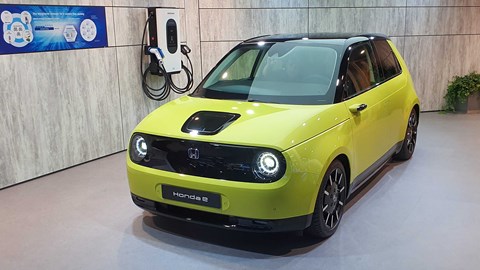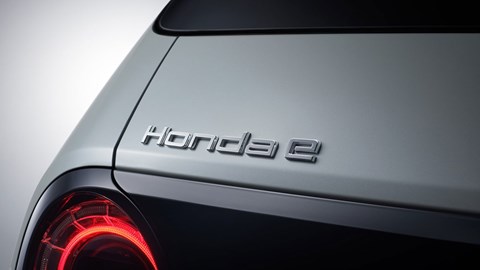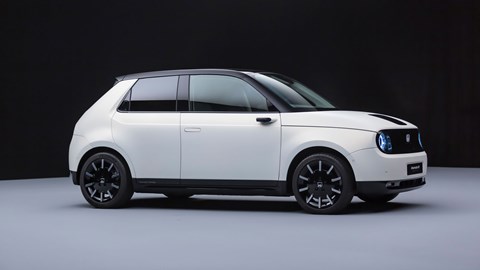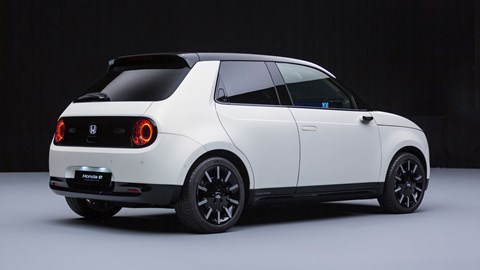► The latest on Honda’s new electric car
► Claimed range of 136 miles, 36 kWh battery
► Comes in two power trims
After a long campaign including a brilliant concept car and plenty of teasers, Honda has finally revealed the full production version of its e electric car. The final version took to the stage at the 2019 Frankfurt motor show.
We’ve already been for a drive in a prototype e, with only minor differences from the car you’ll soon be able to buy. Honda’s also dropped details of the two models that’ll be hitting showrooms, with specs and UK pricing now available. Below you’ll find everything we know about the adorable retromodern EV.
Give us the specifications
The e will come in two power specifications: one with a range-topping 152bhp e-motor and the other with a more conservative 134bhp unit. Honda says the most powerful trim will get from 0-62mph in around 8 seconds – but it’s important to remember this car is more for urban use than anything else; it’ll be more interesting to see just how quick the Honda e is to 30mph instead.

Honda spent the second half of the 20th century mastering the combustion engine – now it must start all over again. But its first electric car will feel like a Honda – that’s the pledge.
‘The difference between electric motors from different manufacturers will be slimmer than perhaps they were with engines,’ says Honda UK managing director David Hodgetts. ‘Electric power already has a reputation for being very reliable, which is one of the key strengths of our combustion engines. It’ll be more difficult to stand out, but with EVs and hybrids the car must hang together as a cohesive package. That’s where we can be strong. I’ve driven it [the e Prototype, in early form] and it didn’t require any adjustments from me – it just felt natural.’

What about the battery?
Honda has confirmed that the e will feature a 36kWh lithium-ion battery that grants a claimed range of over 136 miles.
The company has also revealed several other key details about the new EV’s battery; for starters, it’s positioned centrally in the skateboard of the car to ensure a 50:50 weight distribution – which should aid the rear-drive EV’s handling. It’s also watercooled to ensure the optimum operating temperature and thus deliver the best range.
Honda states that its new EV can be charged using the regular Type 2 AC connection or a CCS2 DC rapid charge plug (an 80% charge in 30 minutes is promised – if you can find a suitably powerful charger).
Our guide to the best electric cars and EVs
What’s the interior like?
Two giant 12.3-inch touchscreens sit side by side on top of the flat-surfaced dashboard (which looks like it’s trimmed in wood, but is actually plastic – although it feels reasonably realistic to touch). Their party piece is a distraction-busting co-pilot mode, enabling the front passenger to search for information (a map location, for example) and then swipe it across to the driver’s screen. thre’s also now a Honda Assistant in the production car, along with a counterpart app.
The screen interface may be rolled out to other Honda production cars in the near future.
Even more futuristically, cameras take the place of door mirrors, displayed on six-inch screens in the corners of the dashboard. In the isolated environment of a photography studio, they appear to work very effectively, showing clear and smooth images of people pacing around the car.
‘It was a challenge to incorporate the cameras, and all of the elements into that huge panel,’ says interior design leader Akinori Myoui. ‘We knew for the future that these elements would be one, so it was important [to do so].’ He tells us the door-mirror camera technology wasn’t developed specifically for this vehicle – Honda was working on the technology separately, and the EV is a timely car to launch the system for production.

Physical over-the-shoulder visibility past the thick C-pillars seems a little tricky, although may prove easier in the real world. Interior space feels relatively cramped for tall occupants. A BMW i3, for instance, is roomier.
A glass roof is standard fit, which impacts slightly on headroom. The boot is also comparatively high and small to accommodate the motor beneath.
It looks quite retro in style?
‘We didn’t intend a retro feel from the beginning, just to have a pure design [but] we realised that ideal and retro [design movement] had a lot in common,’ exterior design project leader Ken Sahara told CAR as he talked us around the e Prototype when it was first revealed. ‘Cars in the ’60s/’70s cars with circular headlights and so on were simpler, and there is a connection somehow [to what we wanted to achieve with this car].’
‘Recent Honda design has been in a more aggressive, sporty direction but I think in the future the differentiation is going to be how rooted a car can be in your everyday life, how friendly, how familiar. It’s a European-centric model and Honda’s presence is not so big in this market. So the timing is a good opportunity to introduce new design items such as frameless doors and pop-out handles.’
The front doors’ flush handles spring out automatically when a hand approaches. The rear doors have conventional handles, disguised next to the window glass.
He says that although packaging the tall batteries was a challenge, designing a battery-electric vehicle in many ways allowed more freedom than a combustion-engined car. ‘I requested shorter overhangs and wider wheels than the Jazz, and it was possible. This car is 50mm wider and 100mm shorter than the Jazz, with the same wheelbase.’
Where the Urban EV concept sported giant wheels, the production car has more demure rims. The e Prototype’s 17-inch wheels are production-spec. They will be an option on top-spec cars; 16s will be standard. They still have relatively wide tyres for the car’s size, to give it a slightly sportier stance.
The e Prototype is finished in a matt white paint finish. The exact same paint won’t be available for production – it’s simply too expensive. A range of body colours will be available but all cars will feature gloss black pillars, roof and sills, like the e Prototype; it helps visually reduce the car’s height.

‘Nowadays cars appear very aggressive,’ concludes project leader Hitomi. ‘We believe customers may be a little fed up with that. A friendlier, cuter car may be welcomed.’
When can I buy the Honda e electric car?
Honda’s set up a reservation website that’s been set up for those wanting to be first in the queue. The brand has also confirmed a range of colours other than just the pearl white we’ve already seen, including a lime green above and deep blue.
Honda Europe’s general automotive manager, Jean-Marc Streng, added that more than 31,000 people in Europe have registered their interest – a number he called ‘overwhelming.’ A full 9000 of those are from the UK, Honda has revealed. The deposits are fully refundable, allowing those who aren’t enamoured by the final pricing or specification of the full production model to withdraw with no consequence.
Supply will be limited
The production version of the e will reach UK early adopters in the first months of next year, but don’t expect to start seeing them on every street in the land.
‘I can’t be sure on volumes, but it’ll be significantly more than hundreds [of cars in 2020],’ says Hodgetts. ‘We’ll be looking to sell the number of cars we need to balance our CAFE [Corporate Average Fuel Economy] requirements. Availability and supply will be limited.’

How much will the Honda e cost?
Initially, we expected the e to cost in excess of £30,000, but the news is more positive than that. Prices for the lower-powered motor variant kick off from £26,160 including the Government’s plug-in car grant, rising to £28,660 for the ‘Advance’ model with greater specification and a higher-powered motor.
Finance packages have only been finalised for Hire Purchase, and start from £299 per month for the base grade. That’s based on a 37-month agreement and a deposit of around £5,900. Stepping up to Advance will see that increase to £349 per month.
That’s undeniably still a lot of money for a car with a small footprint and limited range. Competitors such as the Nissan Leaf and Hyundai Kona Electric are able to travel around twice as far for the same or less money. But Honda doesn’t like such comparisons, pointing out trick features like the cameras that replace wing mirrors and giant twin 12.3-inch touchscreens.
‘It’s a unique proposition,’ says Honda UK’s head of cars Phil Webb. ‘You look at the technology, particularly on the interior of the car, and that puts it on a premium level. Given those features it’ll be good value – look beyond the numbers to the car itself. The innovation here and the confidence: this car takes Honda back to where it belongs.’
‘Renault Zoe, Nissan Leaf – don’t even go there,’ says Honda UK managing director David Hodgetts. ‘This car is not in that space. Even though it’ll be the smallest car in our range, it could well be the top of our range. [The e Prototype’s infotainment certainly looks slicker and more expensive than the NSX’s]. Forget that it’s small and think of it as Honda’s brand leader, and towards the top of our range in terms of pricing.’
What’s next?
With its ultra-cute dedicated battery-electric retro hatch hogging the limelight, Honda’s decided now’s the time to ramp up its commitment to electrification – all new Hondas in Europe will be electrified by 2025.
Honda’s previous target, that two-thirds of its vehicles would be electrified by 2025, was announced in 2017. It cites rapidly growing consumer demand for EVs and an acceleration in its R&D programme for the new, loftier target.
2025 is proving a popular landmark year for such ambitions. Volvo was the trailblazer, and has since announced that half of its cars will be pure battery-electric vehicles by 2025. The period 2025-2030 is widely considered the point at which such cars will come to dominate.
While Honda’s funky battery-electric hatch – due on UK roads in early 2020 for £30-35k – will spearhead its electric strategy, the Japanese car maker will lean heavily on hybrids to reach its new target. The hybrid CR-V went on sale earlier this year, and a hybrid Civic will arrive with the next-generation car in 2021.
Honda’s also announced ongoing work on a Tesla Powerwall-style two-way energy storage system, Honda Power Manager. Compatible with the new BEV, the system will allow customers to manage their electricity; charging the car for use or to store electricity when rates are low, and potentially also transferring it back to the home or selling it on to the grid.
Further electric car reading
The best electric cars and EVs on sale today
Future electric cars: EVs on sale soon
The best hybrids, plug-ins and PHEVs